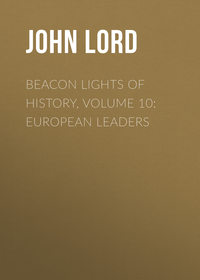 полная версия
полная версияBeacon Lights of History, Volume 14: The New Era
The great value of the electric motor to the world is too evident to need any proof. The number of purposes for which electric motors are now employed is so great that the actual number of motors in daily use is almost incredible, and every year sees this number rapidly increasing.
The above are the more important machines or devices that have been directly derived from Faraday's great investigation as to the production of electricity from magnetism. Let us now inquire briefly as to what useful processes or industries have been rendered possible by the existence of these machines.
Apparently one of the most marked requirements of our twentieth-century civilization is that man shall be readily able to extend the day far into the night. He can no longer go to sleep when the sun sets, and keep abreast with his competitors. Of all artificial illuminants yet employed, the arc and the incandescent electric lights are unquestionably the best, whether from a sanitary, aesthetic, or truest economical standpoint. Now, while it is a well-known matter of record that both arc and incandescent lights were invented long before Faraday's time, yet it was not until a source of electricity was invented, superior both in economy and convenience to the voltaic battery, that either of these lights became commercial possibilities. Such an electric source was given to the world by Faraday through his invention of the dynamo-electric machine, and it was not until this machine was sufficiently developed and improved that commercial electric lighting became possible. The energy of burning coal, through the steam-engine, working the dynamo, is far cheaper and more efficient for producing electricity than the consumption of metals through the voltaic pile.
It is characteristic of the modesty of Faraday that when, in after-life, he heard inventors speaking of their electric lights, he refrained from claiming the electric light as his own, although, without the machine he taught the world how to construct, commercial lighting would have been an impossibility.
The marvellous activity in the electric arts and sciences, which followed as a natural result of Faraday giving to the world in the dynamo-electric machine a cheap electric source, naturally leads to the inquiry as to whether at a somewhat later day a yet greater revolution may not follow the production of a still cheaper electric source. In point of fact such a discovery is by no means an impossibility. When a dynamo-electric machine is caused to produce an electric current by the intervention of a steam-engine, the transformation of energy which takes place from the energy of the coal to electric energy is an extremely wasteful one. Could some practical method be discovered by means of which the burning of coal liberates electric energy, instead of heat energy, an electric source would be discovered that would far exceed in economy the best dynamo in existence. With such a discovery what the results would be no one can say; this much is certain, that it would, among other things, relegate the steam-engine to the scrap-heap, and solve the problem of aerial navigation.
What is justly regarded as one of the greatest achievements of modern times is the electrical transmission of power over comparatively great distances. At some cheap source of energy, say, at a waterfall, a waterwheel is employed to drive a dynamo or generator, thus converting mechanical energy into electrical energy. This electricity is passed over a conducting line to a distant station, where it is either directly utilized for the purpose of lighting, heating, chemical decomposition, etc., or indirectly utilized for the purpose of obtaining mechanical power for driving machinery, by passing it through an electric motor. The electric transmission of power has been successfully made in California over a distance of some 220 miles, at a pressure on transmission lines of 50,000 volts.
The high pressures required for the economical use of transmission lines necessitates the employment of transformers at each end of the line; namely, step-up transformers at the transmitting end, to raise the voltage delivered by the generators, and step-down transformers, at the receiving end, to lower it for use in the various translating devices. These transformers are employed in connection with alternating-current dynamos. Faraday not only gave to the world the first electric generator, but also the first transformer, and one of the first electric motors, and without these gifts the electric transmission of power over long distances, which has justly been regarded as one of the most marvellous achievements of our age, would have been an impossibility.
In high-tension circuits over which such pressures as 50,000 volts is transmitted, no little difficulty is experienced from leakage and consequent loss of energy. This leakage occurs both between the line conductors and at the insulators placed on the pole lines forming the line circuit. The insulators are made either of glass or porcelain, and are of a peculiar form known as triple petticoat pattern. The loss on such lines, due to leakage between wires, is greater than that which takes place at the pole insulators, and is diminished by keeping the circuit wires as far apart as possible.
In the early history of the art, electric transmission of power was effected by means of direct-current generators and motors,–generators and motors through which the current always passed in the same direction. Such generators and motors, however, possessed inconveniences that prevented extensive commercial transmission of power, since, as we have seen, high pressure was necessary for efficiency in such transmission, and the collecting-brushes and commutators employed in all direct-current generators and motors to carry the current from the machine or to the motor, were a constant source of trouble and danger.
When the alternating-current motor first same into general use, it was employed, in connection with the alternating-current generator, in electric transmission systems; but such motors also possess the inconvenience of not readily starting from a state of rest, with their full turning power, or torque, and of therefore being unsuitable where the motor requires to be frequently stopped or started. Had these difficulties remained unsolved, long-distance electric transmission of power, so successful in operation to-day, and which bids fair to be still more successful in the near future, would have been impossible. Fortunately, these difficulties were overcome by the genius of Nikola Tesla, in the invention of the multiphase alternating-current motor, or the induction motor, as it is now generally called. Although Baily, Deprez, and Ferraris had accomplished much before Tesla's time, yet it was practically to the investigations and discoveries made by Tesla, between 1887 and 1891, that the induction motor of to-day is due.
Another requirement of our twentieth-century civilization is rapid transit, either urban or inter-urban, and this is afforded by various systems of electric street railways or electric traction generally, including electric locomotives and electric automobiles. The wonderful growth in this direction which has been witnessed in the last few decades would have been impossible without the electric generator and motor, both gifts of Faraday to the world. Their application in this direction must, therefore, go to swell the debt our civilization owes to the labors of this great investigator.
In the system of electric street-car propulsion very generally employed to-day, a single trolley wheel is employed for taking the driving current from an overhead conductor, suspended above the street. The trolley wheel is supported by a trolley pole, and is maintained in good electric contact with the trolley wire, or overhead conductor. By this means the current passes from the wire down the conductor connected with the trolley pole, thence through the motors placed below the body of the car, and from them, through the track or ground-return, back to the power station. A small portion of the current is employed for lighting the electric lamps in the car. In some systems an underground trolley is employed.
An important device, called the series-parallel controller, is employed in all systems of electric street-car propulsion. It consists of means by which the starting and stopping of the car, and changes, both in its speed and direction, are placed under the control of the motorman. A separate controller is placed on both platforms of the car. The series-parallel controller consists essentially of a switch by means of which the several motors, that are employed in all street cars, can be variously connected with each other, or with different electric resistances, or can be successively cut out or introduced into the circuit, so that the speed of the car can be regulated at will, as the handle of the controller is moved by the motorman to the various notches on the top of the controller box. As generally arranged, the speed increases from the first notch or starting position to the last notch, movements in the opposite direction changing connections in the opposite order of succession, and, therefore, slowing the car. There is, however, no definite speed corresponding to each notch, for this will vary with the load on each car, and with the gradient upon which it may be running.
But there is another valuable gift received by the world as a result of this great discovery of Faraday; namely, that most marvellous instrument of modern times, the speaking telephone. This instrument was invented in 1861, by Philip Ries, and subsequently independently reinvented in 1876, by Elisha Gray and Alexander Graham Bell.
As is well known, it is electric currents and not sound-waves that are transmitted over a telephone circuit. The magneto-electric telephone in its simplest form consists of a pair of instruments called respectively the transmitter and the receiver. We talk into the transmitter and listen at the receiver. Both transmitter and receiver consist of a permanent magnet of hardened steel around one end of which is placed a coil of insulated wire. In front of this coil a diaphragm, or thin plate, of soft iron, is so supported as to be capable of freely vibrating towards and from the magnet pole.
The operation of the transmitting instrument is readily understood in the light of Faraday's discovery. It is simply a dynamo-electric machine driven by the voice of the speaker. As the sound-waves from the speaker's voice strike against the diaphragm, which has become magnetic from its nearness to the magnet pole, electric currents are generated in the coil of wire surrounding such pole, since the to-and-fro motions cause the lines of electro-magnetic force to pass through the wire on the moving coil. The operation of the receiving instrument is also readily understood. It acts as an electric motor driven by the to-and-fro currents generated by the transmitter. As these currents are transmitted over the wire, they pass through the coil of wire on the receiving instrument, and reproduce therein the exact movements of the transmitting diaphragm, since, as they strengthen or weaken the magnetism of the pole, they cause similar motions in the diaphragm placed before it. Consequently, one listening at the receiving diaphragm will hear all that is uttered into the transmitting diaphragm. It was thus, by the combination of the dynamo and motor, both of which were given by Faraday to the world, that we have received this priceless instrument, which has been so potent in its effects on the civilization of the Twentieth century.
The electric telegraph had its beginnings long before Faraday's time. As early as 1847, Watson had erected a line some two miles in length, extending over the housetops in London, and operated it by means of discharges from an ordinary frictional electric machine. In 1774, Lesage had erected in Geneva an electric telegraph consisting of a number of metallic wires, one for each letter of the alphabet. These wires were carefully insulated from each other. When a message was to be sent over this early telegraphic line an electric discharge was passed through the particular wire representing the letter of the alphabet to be sent; this discharge, reaching the other end, caused a pithball to be repelled and thus laboriously, letter by letter, the message was transmitted. How ludicrously cumbersome was such an instrument when contrasted with the Morse electro-magnetic telegraph of to-day, which requires but a single wire; or with the harmonic telegraph of Gray, which permits the simultaneous transmission of eight or more separate messages over a single wire; or with the wonderful quadruplex telegraphic system of Edison which permits the simultaneous transmission of four separate and distinct messages over a single wire, two in one direction, and two in the opposite direction at the same time; or with the still more wonderful multiplex telegraph of Delaney, which is able to simultaneously transmit as many as seventy-two separate messages over a single wire, thirty-six in one direction and thirty-six in the opposite direction. These achievements have been possible only through the researches and discoveries of Oersted, Faraday, and hosts of other eminent workers; for, it was the electro-magnet, rendered possible by Oersted, together with the magnificent discoveries of Faraday, and others since his time, that these marvellous advances in electro-telegraphic transmission of intelligence have become possibilities.
Before completing this brief sketch of some of the effects that Faraday's work has had on the practical arts and sciences, let us briefly examine the generating plants that are either in operation or construction at Niagara Falls.
Some idea of the size of the Niagara Falls generating plant on the American side may be gained from the fact that there have already been installed eleven of the separate 5,000 horse-power generators. The remaining capacity of the tunnel will permit of the installation of 50,000 additional horse-power, or 105,000 horse-power in all.
On the Canadian side of the Falls another great plant is about to be erected with an ultimate capacity of several hundred thousand horse-power. Here, however, the size of the generating unit will be double that on the American side, or 10,000 horse-power. These generators will be wound to produce an electric pressure of 12,000 volts, raised by means of step-up transformers to 22,000, 40,000, and 60,000 volts, according to the distance of transmission. Each of the revolving parts of these machines will weigh 141,000 pounds. To what gigantic proportions has the little infant dynamo of Faraday grown in this short time since its birth!
The low rates at which electric power can be sold in the immediate neighborhood of the Niagara generating plant have naturally resulted in an enormous growth of the electro-chemical industries, for these industries could never otherwise develop into extended commercial applications. Of the total output of, say, 55,000 horsepower at the Niagara Falls generating plant, no less than 23,200 horse-power is used in various electrolytic and electro-thermal processes in the immediate neighborhood. Some of the more important consumers of the electric power, named in the order of consumption, are for the manufacture of the following products: calcium carbide, aluminium, caustic soda and bleaching salt, carborundum, and graphite.
Calcium carbide, employed in the production of acetylene gas, either for the purposes of artificial illumination, or for the manufacture of ethyl alcohol, is produced by subjecting a mixture of carbon and lime to the prolonged action of heat in an electric furnace.
Aluminium, the now well-known valuable metal, present in clay, bauxite, and a variety of other mineral substances, is electrolytically deposited from a bath of alumina obtained by dissolving bauxite either in potassium fluoride or in cryolite. Aluminium is now coming into extended use in the construction of long-distance electric power transmission lines.
Caustic soda and bleaching salt are produced by the electrolytic decomposition of brine (chloride of sodium). The chlorine liberated at the anode is employed in the manufacture of bleaching-salt, and the sodium is liberated at a mercury cathode, with which it at once enters into combination as an alloy. On throwing this alloy into water the sodium is liberated as caustic soda.
Carborundum, a silicide of carbon, is a valuable substance produced by the action of the heat of an electric furnace on an intimate mixture of carbon and sand. It has an extensive use as an abrasive for grinding and polishing.
Artificial graphite is another product produced by the long-continued action of the heat of the electric furnace on carbon under certain conditions.
According to reports from the United States Geological Survey, the graphite works at Niagara Falls produced in 1901, 2,500,000 lbs. of artificial graphite, valued at $119,000. This was an increase from 860,270 lbs., valued at $69,860 for 1900, and from 162,382 lbs., valued at $10,140, in 1897, the first year of its commercial production. In 1901, more than half of the output was in the form of graphitized electrodes employed in the production of caustic soda and bleaching salt, and in other electrolytic processes.
The Niagara Falls power transmission system stands to-day as a magnificent testimonial to the genius of Faraday, and as a living monument of the varied and valuable gifts his researches have bestowed upon mankind. For here we have not only the dynamo, motors, and transformers that he gave freely to the world, not only the alternating-current transformer, and the system of transmission of power, but we even find that the principal consumers of the enormous electric power produced are employing it in carrying on some of the many processes in electro-chemistry, a science that he had done so much to advance.
Among some of the surprises electro-chemistry may have in store for the world in the comparatively near future, may be a nearer approach to a mastery of the laws which govern the combination of elementary substances when under the influence of plant-life. If these laws ever become so well known that man is able to form hi his laboratory the various food products that are now formed naturally in plant organisms, such a revolution would be wrought that the work of the agriculturist would be largely transferred to the electro-chemist. Some little has already been done in the direct formation of some vegetable substances, such as camphor, the peculiar flavoring substance present in the vanilla bean, and in many other substances. Should such discoveries ever reach to the direct formation of some food staple, the wide-reaching importance and significance of the discovery would be almost beyond comprehension.
But, while the direct electro-synthetic formation of food products is yet to be accomplished on a practical scale, the problem appears to be nearing actual solution in an indirect manner. It has been known since the time of Cavendish, in 1785, that small quantities of nitric acid could be formed directly from the nitrogen and oxygen of the atmosphere by the passage of electric sparks; but heretofore, the quantity so found has been too small to be of any commercial value. Quite recently, however, one of the electro-chemical companies at Niagara Falls has succeeded in commercially solving the important problem of the fixation of the nitrogen of the atmosphere; it being claimed that the cost of thus producing one ton of commercial nitric acid, of a market value of over eighty dollars, does not greatly exceed twenty dollars. Since sodium nitrate can readily be produced by the process, and its value as a fertilizer of wheat-fields is too well known to need comment, there would thus, to a limited extent, be indirectly solved the electro-chemical production of food staples.
Faraday's high rank as an investigator in the domain of natural science was fully recognized by the learned societies of his time, by admission into their fellowships. As early as 1824, he was honored by the Royal Society of London by election as one of its Fellows, and in 1825 he had become a member of the Royal Institution. It is recorded of the great philosopher that the membership in the Royal Institution was the only one which he personally sought; all others came unsought, but they came so rapidly from all portions of the globe that in 1844 he was a member of no less than seventy of the leading learned societies of the world. Ries, the German electrician, so well known in connection with his invention of the speaking telephone, addressed Faraday as "Professor Michael Faraday, Member of all the Academies." Besides his membership in the learned societies, Faraday received numerous degrees from the colleges and universities of his time. Among some of these are the following: The University of Prague, the degree of Ph.D.; Oxford, the degree of D.C.L.; and Cambridge, the degree of LL.D. He also received numerous medals of honor, and was offered the Presidency of the Royal Society, which, however, he declined, as he did also a knighthood proffered by the government of England. Faraday died on the 25th of August, 1867, after a long, well-spent, useful life.
We have thus briefly traced some of the more important discoveries of Michael Faraday. Many have necessarily been passed by, but what we have given are more than sufficient to stamp him as a great philosopher and investigator. Speaking of Faraday in this connection, Professor Tyndall says: "Take him for all in all, I think it will be conceded that Michael Faraday is the greatest experimental philosopher the world has ever seen; and I will add the opinion that the progress of future research will tend not to diminish or decrease, but to enhance and glorify, the labors of this mighty investigator."
AUTHORITIES
Experimental Researches in Electricity. By Michael Faraday. From the Philosophical Transactions.
Abstracts of the Philosophical Transactions from 1800 to 1837.
Faraday's Experimental Researches in Electricity and Magnetism. 3 vols.
Life and Letters of Faraday. By Dr. Bence Jones.
Michael Faraday. By J.H. Gladstone.
Students' Text-Book of Electricity. By Henry M. Noad. Revised by W.H. Preece.
Michael Faraday. By John Tyndall.
Pioneers of Electricity. By J. Munro.
Dynamo-Electric Machinery. By Silvanus P. Thompson.
A Dictionary of Electrical Words, Terms, and Phrases. By Edwin J. Houston.
Electricity and Magnetism. By Edwin J. Houston.
Electricity One Hundred Years Ago and To-Day. By Edwin J. Houston.
Magnetism; Electro-Technical Series. By Edwin J. Houston and Arthur E. Kennelly.
Electro-Dynamic Machinery. By Edwin J. Houston and A. E. Kennelly.
RUDOLF VIRCHOW
Stagnation was the state of medicine when the Nineteenth Century opened. It was only three years before that Jenner had announced and demonstrated the protective efficacy of vaccination against small-pox. His teaching, in spite of the vehement cavillings of the "antis" of his day, gained credence readily, and vaccination speedily became recognized and was constantly resorted to, but hardly any attempt at perfecting the practice was made until after more than fifty years had elapsed. His discovery–or, rather, his proof of the truth of a rustic tradition–fell like a pebble into the doldrums; the ripple soon subsided, and nobody was encouraged to start another. At the present time such an announcement would be promptly followed by investigations leading up to such doctrines as that of the attenuation of viruses and that of antitoxines. But the times were not ripe for anything of that sort; medicine reposed on tradition, or at best gave itself only to such plausibilities in the way of innovation as were cleverly advocated. Physicians strove not to advance the healing art; as individuals, they were content to rely on their manners, their tact, and their assumption of wisdom. In short, the body medical was in a state of suspended animation, possessed of a mere vegetative existence.
The Humoral pathology, or that doctrine of the nature of disease which ascribed all ailments to excess, deficiency, or ill "concoction" of some one of the four humors (yellow and black bile, blood, and phlegm), had not yet lost its hold on men's convictions, or at least not further than to make them look upon exposure to cold and errors of diet as amply explanatory of all diseases not plainly infectious. The medical writers who were most revered were those who busied themselves with nosology; that is to say, the naming and classifying of diseases. Wonderful were the onomatological feats performed by some of these men, and most diverse and grotesque were the data on which they founded their classifications. To label a disease was high art; to cure it was something that Providence might or might not allow. In the treatment of "sthenic" acute diseases (meaning those accompanied by excitement and high fever), blood-letting, mercury given to the point of salivation, antimony, and opium, together with starvation (all included under the euphemism of "lowering measures"), were the means universally resorted to and reputed "sheet anchors." Some advance had been made from the times when disease had been looked upon as an entity to be exorcised, but it was still so far regarded as a material thing that it was to be starved out.









